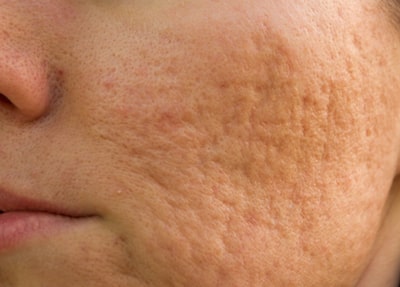For many young people, dealing with acne can be tedious and frustrating. Acne flare-ups can be bad for your confidence as it isn’t visually or aesthetically appealing. Dealing with scars from acne can seem like double punishment since you’ve dealt with the pimples and now you have the scars to show as a reminder. The occasional picking and squeezing that tends to happen with dealing with the acne further increase the risks of scars appearing. Acne scars tend to be stubborn and there is no one solution that makes it easy to deal with them. Instead, there are many options whose effectiveness depends on the severity of the scars, the scar type, and the quality of your skin.
Common Acne Scars
The different types of acne scars vary depending on skin types and severity of the acne. The most common scar is the atrophic scar as it forms when not enough collagen is being produced when the wound is healing. There are many instances of this type of scar that includes the wide U-shaped boxcar scar, the narrow V-shaped ice pick scar (that tends to be the most difficult to treat) and the rolling scar.
The hypertrophic (or raised) scar tends to appear after a serious case of chest and back acne as they appear above the surface of the skin caused by too much collagen when healing.
Discoloration and dark spots that appear after a case of acne are often mistaken to be a scar but this is not the case. These spots tend to go away or fade after a few months without treatment.

Acne Scars Treatment
When starting your treatment for scars, it is important to treat your acne first and seek the help of a dermatologist. A dermatologist will be able to tell you exactly what is going on with your skin so you will know what treatment would be best for you. As stated before, the type and condition of the skin makes the effectiveness of treatments vary. The dermatologist can also let you know if your condition is related to the acne or not.
- AHAs – or alpha hydroxy acids – tend to be found in products treating acne and work to remove dead skin and prevent clogged pores. This process is done by exfoliating the outer layer of the skin. Lactic acid is found in many products and is often recommended as a home treatment with it being in many peels, ointments and even distilled apple cider vinegar.
- Many lotions and face cleansers contain salicylic acids which are also found in many different treatments. Salicylic acids work to reduce redness and swelling while exfoliating and clearing pores. Products containing salicylic acids can be used in daily routines or they can be used for less frequent chemical peels. One of the side effects of salicylic acids is that it tends to cause dryness or irritation and it is recommended that those with sensitive skin use it less often.
- Given the fact that sun exposure can make scars much more visible or darken them, it’s also recommended that you wear sunscreen every day. However, while “at home treatments” can help mild or moderate situations, some cases will require the care of a skin specialist or healthcare provider.
- One of the more effective and common treatments for acne scars is dermabrasion. Dermabrasion employs the help of a wire brush to deeply exfoliate the skin. Chemical peels use a strong acid to strip away the top layer of skin and tends to have much more dramatic results in comparison to the ones used at home.
- An option that works similarly to both dermabrasion and chemical peels is the use of laser resurfacing. This removes the top layer of skin and actually has a faster healing time. However, when undergoing this treatment, you must remain bandaged until you are fully healed. There is also the fact that laser resurfacing isn’t as effective on those with dark skin.
- The use of injectables has become an option to treat acne scars as some healthcare providers have started to use them. Fillers can be made with collagen and/or commercial filler and injected into the skin to fill out areas that need a more plump and smooth look. If you deal with boxcar and rolling scars, fillers would be your best option. For the most part, fillers would have to be redone every 6 to 18 months but there are some out there that are permanent and wouldn’t require more than the initial injections.
- For the more deep and raised scars, there’s always the option of surgery. Dermatologists or surgeons can completely remove the scar and, while it leaves behind a scar of its own, it can eventually fade with time.
While most these treatments may work, there is also the possibility of more permanent scars that may not be able to be eliminated. However, providers can offer solutions to reduce their appearance. At the end of the day, in order to reduce the chances of further scarring it is required that you refrain from picking at your skin during acne breakouts as it can irritate and damage the tissue that will eventually lead to scarring.
– JM
